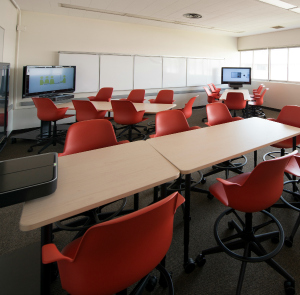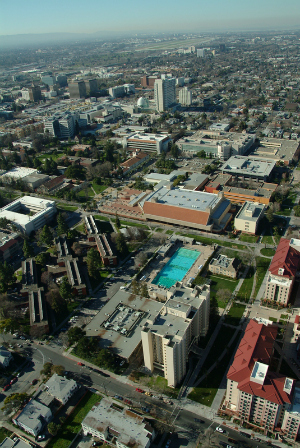By Information Technology Services and the Division of Academic Affairs
Two years ago, San Jose State University launched a five-year, $28 million initiative to support faculty members in using and applying next generation collaboration technologies to student learning. This series of investments is addressing specific information technology infrastructure areas deemed essential to realizing the “Unbounded Learning” capabilities envisioned in SJSU’s Strategic Plan: Vision 2017. Although the roll out will continue for several more years, SJSU is already experiencing tangible, positive results detailed below and in these frequently asked questions.
Wi-Fi
In fall 2012, Wi-Fi coverage was spotty and unreliable. It was impossible to teach a class or conduct an exam with materials on the web. Students drifted around campus, searching for a signal. There was no Wi-Fi access for guests and students living in our residence halls. All this has changed.
Over the past two years, SJSU has expanded its free, secure, wireless Internet service to serve all students, faculty, staff and guests, including prospective students and family members. Wi-Fi is reliable and available in all classrooms, campus buildings and student residences. The number of concurrent Wi-Fi connections during the day is more than 11,000 devices, double what was possible two years ago. Students have reported seeing Internet speeds over 100 megabytes.
Two years ago, students living in SJSU’s residence halls had to bring their own Internet routers to campus if they wanted to access the web. Today, SJSU provides Internet access to students living on campus, allowing them to connect with the content they need from the desks in their rooms.
Collaboration Technologies
Essential to realizing SJSU’s Strategic Plan are several key technologies that support robust, ubiquitous connectivity and unfettered video and audio communications among students, faculty, staff and experts worldwide.
For example, WebEx web conferencing allows professors to mix traditional and virtual class sessions throughout the semester, adding flexibility to their curricula and making the classroom an unbounded space for collaboration, anytime and anywhere.
Next Generation Classrooms
In the past two years, SJSU outfitted five classrooms and one auditorium with high-definition, interactive video conferencing that includes recording, indexing and word-search capabilities for all classroom exercises including lectures. Additionally, 17 conference rooms and offices were upgraded with similar functionalities.
In these rooms, students, faculty and staff can access interactive lectures by professors or industry experts worldwide. Students can even see exhibits shared by those speaking from remote locations.
Before this technology was installed, the best we could do was a few people sitting around a speaker phone. Now, classrooms feature high-speed, interactive video streaming.
Instructors have found the technology productive and useful. Based on faculty experience and feedback, additional classroom configurations will be developed and implemented.
Here are specific examples of how Next Gen classrooms are being used today.
The School of Journalism and Mass Communication
- Student groups present advertising projects to industry experts including a New York ad agency.
- Previously, presentations were filmed and sent to New York. Feedback came days or weeks later.
- Now, a classroom connection is made with the ad agency using Telepresence.
- Recordings are available for playback later. This demonstrates how IT supports the academic mission.
- The results include enhanced experiential learning capabilities; real-time feedback from industry experts; and the ability to review feedback from industry experts.

Public health students gain real-world and global experience by connecting with an Alebrije artisan community in Mexico (CASA Blog image).
The Master’s in Public Health Program
- From admissions to graduation, the program has been redesigned to incorporate new technology.
- For example, virtual classes are conducted via WebEx and multimedia course content is provided online.
- In addition, the program connects with an Alebrije artisan community in Mexico to provide real-world experiences to students. Video conferencing with the artisan families enables more frequent and personal contact.
- Results include enhanced experiential learning capabilities; a new social responsibility program for high school students interested in the Alebrije project; reduced costs for students traveling to and from campus; and flexibility for students seeking to meet personal and job responsibilities.

The Connie L. Lurie College of Education established a research effort to evaluate 21st century classrooms (Carl Best photo).
The Connie L. Lurie College of Education
- The college seeks to develop tomorrow’s leading educators.
- Instructors teach a program demonstrating how to bring tech innovations into today’s schools.
- The SJSU classroom solution includes SmartBoards, mobile and flexible furniture, room archetypes, Wi-Fi, and Mediascape video booths.
- The college instituted collaborative applications such as Skype, WebEx and Canvas to extend the classroom and support a flipped-classroom approach.
- Results include the establishment of a research effort to evaluate the qualitative and quantitative impacts of the 21st century classroom program.
Computer Labs
Outdated computer labs were once all too common at SJSU. In the past two years, more than 1,600 computers have been refreshed including the replacement of hundreds of machines that were eight or more years old. Next steps include virtualizing the labs to allow students the freedom to use any Internet device to access the computer labs and up-to-date software.
Unified Communication
Before infrastructure improvements began in 2012, SJSU had five distinct phone systems of various ages and capabilities. SJSU’s commitment to agility through technology strongly suggested the need for a modern campus communication system. This resulted in plans to replace all the antiquated phone systems in favor of a single solution with capabilities beyond anything previously experienced on campus.
Four of the five systems have been replaced. New phone instruments utilizing Voice over Internet Protocol (VoIP) are being distributed to faculty, staff, and classrooms. These phones support advanced services including audio and video communication from hardwired, wireless and mobile devices.
Now, faculty and staff phone numbers can “go mobile.” This means all phone features, including video, forwarding and voicemail, can be accessed on laptops, desktops and mobile phones. Additional unified communication functions include instant messaging with SJSU employees and instant WebEx meetings, allowing faculty and staff to better support students and each other.


